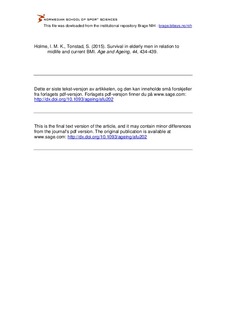| dc.contributor.author | Holme, Ingar Morten K. | |
| dc.contributor.author | Tonstad, Serena | |
| dc.date.accessioned | 2016-05-25T12:48:09Z | |
| dc.date.available | 2016-05-25T12:48:09Z | |
| dc.date.issued | 2015-01-21 | |
| dc.identifier.citation | Age and Ageing. 2015, 44, 434-439 | nb_NO |
| dc.identifier.uri | http://hdl.handle.net/11250/2390434 | |
| dc.description | Dette er siste tekst-versjon av artikkelen, og den kan inneholde små forskjeller fra forlagets pdf-versjon. Forlagets pdf-versjon finner du på www.sage.com: http://dx.doi.org/10.1093/ageing/afu202 / This is the final text version of the article, and it may contain minor differences from the journal's pdf version. The original publication is available at www.sage.com: http://dx.doi.org/10.1093/ageing/afu202 | nb_NO |
| dc.description.abstract | Background: the relationship between BMI and mortality is U-shaped in the elderly but may be modified by midlife BMI and change in weight.
Objective: to elucidate mortality prediction by BMI trajectory in older men.
Subjects: the Oslo cohort of men born in 1923–32 were screened for BMI and cardiovascular risk in 1972–73. Survivors were rescreened at ages of 68–77 years, and all-cause mortality was followed from 2000 to 2011.
Methods: we calculated Cox regression proportional hazards for 11-year mortality rates in relation to BMI change among 5,240 men with no reported disease in 1972–73 and complete data. Models were adjusted for demographics, medications and disease. Men with BMI < 25 kg/m2 in midlife (1972–73) and in 2000 were the reference group.
Results: men whose BMI changed from <25 kg/m2 in midlife to 25–29.9 kg/m2 in 2000 carried the lowest mortality risk (hazard ratio [HR] 0.84; 95% confidence interval [CI] 0.75–0.94). Men with BMI ≥ 30 kg/m2 in midlife were at highest risk (HR 1.79; 95% CI 1.12–2.88 if reclassified to 25–29.9 kg/m2 in 2000 and HR 1.39; 95% CI 1.05–1.85 if BMI remained ≥30 kg/m2 in 2000). Men with BMI 25–29.9 kg/m2 in midlife that reclassified to <25 kg/m2 in 2000 had increased risk. Findings were similar when percentage change in BMI was the outcome.
Conclusion: survival in older men with normal weight at midlife was associated with BMI gain after midlife while midlife obesity increased risk regardless of subsequent change. | nb_NO |
| dc.language.iso | eng | nb_NO |
| dc.publisher | Oxford University Press | nb_NO |
| dc.subject | BMI | nb_NO |
| dc.subject | mortality | nb_NO |
| dc.subject | ageing | nb_NO |
| dc.subject | older people | nb_NO |
| dc.title | Survival in elderly men in relation to midlife and current BMI | nb_NO |
| dc.type | Journal article | nb_NO |
| dc.type | Peer reviewed | nb_NO |
| dc.subject.nsi | VDP::Medical disciplines: 700 | nb_NO |
| dc.subject.nsi | VDP::Medical disciplines: 700::Clinical medical disciplines: 750 | nb_NO |
| dc.source.journal | Age and Ageing | nb_NO |
| dc.description.localcode | Seksjon for idrettsmedisinske fag / Department of Sports Medicine | nb_NO |
